If you have one or more children, there are some rashes that it just makes sense to know about. Impetigo is one of them. A common staph infection, it can spread if you don’t catch the signs right away. In this post, Danielle shares easy home remedies for impetigo. Chances are, you have them in your kitchen right now!
What is impetigo?
Impetigo is a bacterial skin infection with small, crust filled blisters that look like “honey.” It begins by the nose and mouth and eventually spreads to the hands and feet as well a torso.
The bacteria that cause impetigo is group A strep or staph.
During an infection, the bacteria make their way into the skin through a bite, scrape, or irritation. Because of this, you’re more likely to see impetigo following a cold or with allergies since the skin of the nose (or mouth) is worn down.
Likewise, those with eczema are at a higher risk of contracting impetigo.
While the CDC does not currently track impetigo cases, the UK sees 2 out of every 100 children suffer from the illness each year.
Impetigo is highly contagious and common among infants and young children. Adults and seniors with a weakened immune system also have a greater risk of contracting the infection.
What does impetigo look like?
Impetigo blisters have a substance inside, will break, and then look crusty and honey-colored. These small blisters pop very easily and are not tough or extremely inflamed. They spread rapidly and nearly always begin around the nose and mouth.
Children with impetigo may complain of itching or soreness.
This form of impetigo is called non-bullous impetigo. It’s less serious and more common than bullous impetigo and ecthyma.
Those with bullous impetigo have larger blisters containing cloudy pus. The blisters start in the neck or diaper area instead of the face.
With ecthyma, you get deep blisters that are painful and not easily popped. This can be a serious condition leading to secondary infection or scarring. These conditions should receive medical attention.
By the way, these are NOT impetigo:
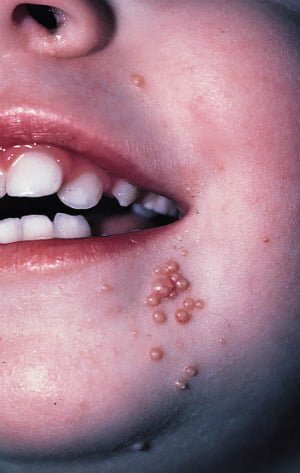
(Molluscum Contagiosum- source)
What are the first signs of impetigo?
When impetigo begins, it looks like small, red blemishes near the nose or mouth. These blemishes appear briefly as blisters, but with a toddler who is always touching his face, you may even miss that they are blisters.
Once the blisters pop, they leave what looks like a small, open wound. This wound quickly fills with a honey-colored crust.
Ideally, you catch impetigo quickly before it spreads.
While a fever with impetigo isn’t common, it is possible. Along with a low-grade fever, you might notice fatigue and complaints of nausea. But pay attention to high fever or extreme fatigue, as this could mean the strep bacteria has invaded the body or become systemic.
You should stay home when you or your child has impetigo.
Impetigo is highly contagious. And although it’s not contagious to those with well-maintained immune systems and no open wounds, you don’t know who that is and it’s better to be safe than sorry. Frequent hand washing and normal, healthy hygiene habits will keep impetigo from spreading in most situations.
Can impetigo go away on its own?
Impetigo, when in a clean environment, can definitely go away on its own.
However, when we are dealing with a little one, it’s hard to keep them from touching the blisters, and touching blisters will continue to spread the infection.
Natural remedies are available and extremely easy to use.
A possible complication to impetigo is a secondary infection and you don’t want to deal with that. So, this is one illness I highly suggest treating (naturally) right away and with a watchful eye (partially for your own sanity).
My home remedies for impetigo
Impetigo blisters will not automatically heal in a few hours. You will need to wait them out. So how can you make impetigo heal faster?
First, clean the area as best you can, being careful not to wipe any additional area. I would use warm water with tea tree oil or apple cider vinegar.
Second, apply a natural antibiotic ointment. Yes, to each spot. Anything with antibiotic properties will do, but below are some well-known and tested home remedies for impetigo. Honey would be my first choice.
Finally, keep your little one calm, comfortable, well rested, and well hydrated to fight impetigo. Be sure your child keeps their hands away from the nose and mouth (I know, easier said than done) and ask them to not touch the blisters or itch them.
More home remedies for impetigo:
- Dab the skin with apple cider vinegar to limit bacterial growth and lessen itching.
- Use goldenseal to stop skin infection. An ointment containing infused goldenseal is a great idea to have on hand for impetigo, but also for any scrape, burn, or wound.
- Cover the blister with manuka honey. It will stick to the wound entirely and boasts some of the highest antibacterial properties known to man, even helping stop MRSA. This is my go-to remedy for impetigo blisters.
- For a stubborn case of impetigo, try grapefruit seed extract. It has been shown to be one of the best ways to fight staph infections and MRSA, particularly when combined with geranium essential oil like this.
- Try tea tree oil. (We like this one.)
- Make teas or soups with ginger, garlic, and turmeric to help the body fight impetigo and any secondary infections.
What ointment is good for impetigo?
Manuka honey is simple and the gold standard for dealing with impetigo.
A salve of antibacterial herbs is another popular home remedy for impetigo. If you want to make your own salve, use this recipe with goldenseal and add tea tree oil too.
Over-the-counter antibiotic ointments will also work, but limiting these is a good idea to avoid excessive damage to the microbiome (aka bacteria balance in your body).
Do you need oral antibiotics for impetigo?
Most conventional doctors will prescribe topical or even oral antibiotics for impetigo.
While this may be necessary, impetigo is easily treated at home with natural antibiotic ointments. If you keep up on applying this ointment, you will see impetigo lessen in a few days. You will also avoid a trip to the doctor and a prescription.
Impetigo is an infection of the skin. So unless the infection has definitely gone deeper, oral antibiotics should not be necessary.
Because doctors tend to overprescribe oral antibiotics and this throws the gut out of balance, it’s best to avoid using them unless an internal infection is clear.
A possible complication of all types of impetigo, though much less likely for non-bullous impetigo, is cellulitis.
Cellulitis is a deep infection in the skin. If the blisters do not heal or one looks inflamed and infected, be sure to contact your doctor and get it checked out. This is when you may need antibiotic therapy.
Impetigo is often a right of passage in childhood. It’s common and can spread. However, it doesn’t have to be mean a trip to your doctor’s office.
Use these natural remedies to quickly nip it in the bud and stop it from spreading. Knowing the signs of impetigo and home remedies to quickly treat it is a good idea for every natural mama.





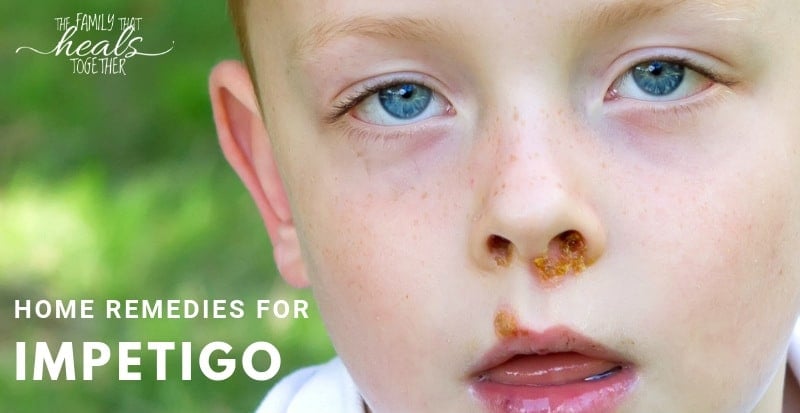



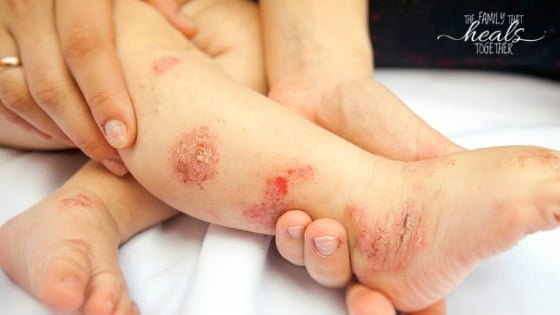
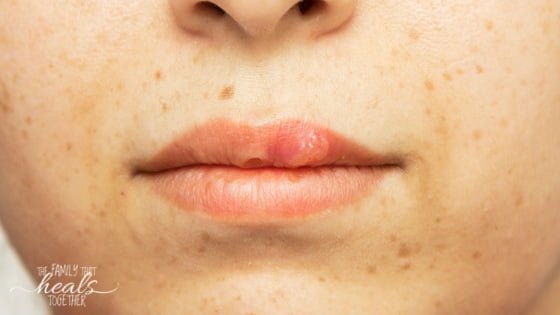
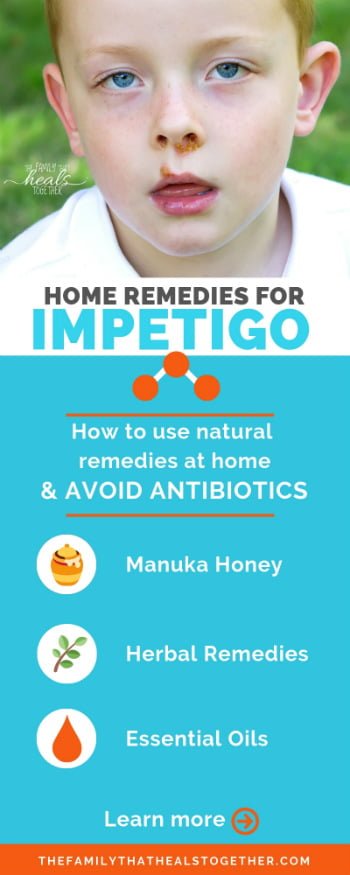

To help people recognize impetigo, you might consider editing the part stating where it starts and how it spreads. That may be one common pattern, but it wasn’t our experience — which is part of the reason my son’s impetigo spread so much before we figured out what it was! His started on the back of his head, under his hair (possibly where there was already a break in the skin) and spread down his neck and all over his torso and face. We went with antibiotic ointment because it was already so advanced, and it cleared up immediately. Neither his impetigo nor the small patch I had seemed to respond to tea tree or herbal ointment. I almost never use antibiotics — I didn’t even take my son to the doctor when he had whooping cough — but impetigo seems to be one time when they make sense.
Thank you for sharing your experience Shayla.
I made a mixture of 1 tsp honey, 1 tsp coconut oil, 10 drops each of clove oil and tea tree oil to kill a scabies outbreak which quickly turned into impetigo overnight. Although this concoction is a sticky uncomfortable remedy, it really provides relief from all the itching and helped stop the weeping. Even though you try not to scratch and create open stores during the day, it’s very difficult at night when you scratch while your sleeping and don’t know till you wake up and look like you got in a fight with a rose bush hahaha. Tea tree has always been my go to, but honey is now on my list.